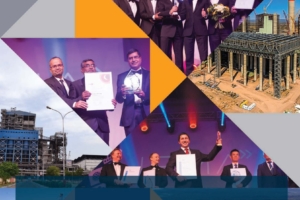Implementation of artificial intelligence into risk management decision-making processes in construction projects
Risk management is nowadays a standard methodology that can be implemented in any construction project; nevertheless, the analysis of risks is in the majority of the cases performed only qualitatively. In addition, formal quantitative methods are needed to provide more certainty for project costs and delays in the delivery process. Risk management is the application of the risk management process which consists in: Risk identification – Risk analysis – Risk evaluation & response – Risk verification & monitoring – Risk planning & controlling The state of the art of Risk management in the praxis is described. It is a present challenge implementing the process in construction industry. It is a future challenge to integrate Risk management in every process of a company means “operational”, “economical”, and “strategical”. This Enterprise Risk Management (ERM) will be a need in the future management processes. Key aspects for implementing formally such systems with the private firms or with government agencies are discussed. Successful Risk management needs effective tools. From the sub processes of Risk management, Risk analysis is the most important for performing an effective quantitative assessment. This paper presents a methodology of how to perform a quantitative risk analysis in order to develop a formal risk management, while joining Artificial Neuronal Networks with the execution of Monte Carlo Simulation. Artificial Neuronal Networks (ANNs) is one of the new methods from the artificial intelligence field that have emerged and found its applicability in risk analysis. They allow predicting values from de-fined data banks. Monte Carlo is applicable simulating risks, and the initial values are defined by ANNs. Consequently the combination of both methods is a strong engineering tool for the Risk analysis process. The paper demonstrates its applicability in construction projects together with the use data from the praxis.
امروزه مدیریت ریسک یک روش استاندارد است که می تواند در هر پروژه ساختمانی اجرا شود. با این حال ، تجزیه و تحلیل خطرات در اکثر موارد فقط به صورت کیفی انجام می شود. علاوه بر این ، روش های کمی رسمی برای اطمینان بیشتر در هزینه های پروژه و تأخیر در روند تحویل مورد نیاز است. مدیریت ریسک کاربرد فرآیند مدیریت ریسک است که شامل موارد زیر است: شناسایی ریسک – تجزیه و تحلیل ریسک – ارزیابی و پاسخ ریسک – تأیید و کنترل ریسک – برنامه ریزی و کنترل ریسک وضعیت هنر مدیریت ریسک در عمل شرح داده شده است. این یک چالش کنونی است که فرآیند را در صنعت ساختمان اجرا می کند. ادغام مدیریت ریسک در هر فرآیند شرکت به معنای “عملیاتی” ، “اقتصادی” و “استراتژیک” یک چالش آینده است. این مدیریت ریسک سازمانی (ERM) در فرآیندهای مدیریت آینده یک نیاز خواهد بود. جنبه های اصلی برای اجرای رسمی چنین سیستم هایی با شرکت های خصوصی یا سازمان های دولتی مورد بحث قرار گرفته است. مدیریت موفقیت آمیز ریسک به ابزارهای موثری نیاز دارد. از زیر فرایندهای مدیریت ریسک ، تجزیه و تحلیل ریسک مهمترین مورد برای انجام یک ارزیابی کمی موثر است. در این مقاله ضمن پیوستن به شبکه های عصبی مصنوعی با اجرای شبیه سازی مونت کارلو ، روش انجام چگونگی انجام تجزیه و تحلیل ریسک کمی به منظور توسعه مدیریت رسمی ریسک ارائه شده است. شبکه های عصبی مصنوعی (ANN) یکی از روش های جدید در زمینه هوش مصنوعی است که ظهور کرده و کاربرد آن را در تجزیه و تحلیل ریسک پیدا کرده است. آنها امکان پیش بینی مقادیر را از بانک های داده جریمه نشده فراهم می کنند. مونت کارلو برای شبیه سازی خطرات قابل اجرا است و مقادیر اولیه توسط شبکه های عصبی ملی تعریف می شوند. در نتیجه ترکیب هر دو روش یک ابزار مهندسی قوی برای فرایند تجزیه و تحلیل ریسک است. این مقاله کاربرد آن در پروژه های ساختمانی همراه با استفاده از داده های عملی را نشان می دهد.

 Add to favorites
Add to favorites 





دیدگاه خود را ثبت کنید
تمایل دارید در گفتگوها شرکت کنید ؟در گفتگو ها شرکت کنید!